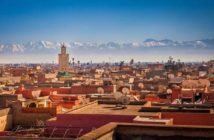RedOrbit

The standard model for mountain structure, in which high topography must have deep roots for support, is defied by the Atlas Mountains, according to a new study from the Earth Sciences department at the University of Southern California (USC).
The team of scientists created a new model which reveals that the Atlas Mountains are floating on a layer of hot molten rock flowing beneath the lithosphere — the Earth’s most rigid outer layer. The study, published in Geology and highlighted in Nature Geoscience, shows that the molten rock might come from as far away as the volcanic Canary Islands, which are just off the shore of northwestern Africa.
“Our findings confirm that mountain structures and their formation are far more complex than previously believed,” said Meghan Miller, assistant professor of Earth sciences at the USC Dornsife College of Letters, Arts and Sciences.
In much the same way a tall iceberg doesn’t simply float on the surface of the water, but is supported by a large submerged mass of ice, a well-established model of the lithosphere suggests that the height of the Earth’s crust must be supported by a commensurate depth. Earth scientists call this property “istostacy.”
“The Atlas Mountains are at present out of balance, likely due to a confluence of existing lithospheric strength anomalies and deep mantle dynamics,” Thorsten Becker, professor of Earth sciences at USC Dornsife, said.
To measure the thickness of the lithosphere beneath the Atlas Mountains in Morocco, the scientists used 15 seismometers to analyze 67 distinct seismic events. This allowed the team to use the Earth’s vibrations to “see” into the deep subsurface.
Miller and Becker found that while the Atlas Mountains reach heights of over 13,000 feet, the crust beneath only reaches a depth of around 22 miles. This is about 9 miles shy of traditional model predictions.
“This study shows that deformation can be observed through the entire lithosphere and contributes to mountain building even far away from plate boundaries” Miller said.
The timing and effects of the mountain building on other geological processes will now be the focus of further research in Miller’s lab.






